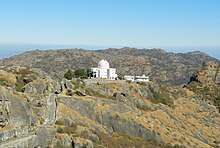Mt Abu Observatory

Observatory as seen from Guru Shikhar.
|
|
| Location |
Rajasthan, Sirohi district, India |
|---|---|
| Coordinates | 24°39′17.34″N 72°46′45.18″E / 24.6548167°N 72.7792167°ECoordinates: 24°39′17.34″N 72°46′45.18″E / 24.6548167°N 72.7792167°E |
| Established | 1990 |
| Website | Physical Research Laboratory |
|
[]
|
|
The Mount Abu InfraRed Observatory is located near the town Mount Abu in the state of Rajasthan. The observatory is at an altitude of 1680 metres and is adjacent to Guru Shikhar, highest peak of the Aravalli Range. The 1.2 m Infrared Telescope at Mount Abu is the first major facility in India specifically designed for ground based infrared observations of celestial objects. Further the low amount of precipitable water vapour (1–2 mm during winter) at Guru Shikhar makes it a good site for the infrared telescope observations. The site has been found to be good (about 150 cloud free nights per year) for astronomical observations.
The Observatory is located near Guru Shikhar, the highest peak of the Aravalli Range at an altitude of 1680 m. Mt Abu is about 28 km from the Abu Road railway station and about 240 km from Ahmedabad. MIRO is operated by the A&A Division of the Physical Research Laboratory, a unit of Department of Space, Government of India, Ahmedabad.
Mt. Abu has about 200 cloud-free nights of which 150 nights a year can be used for photometric observations. It has a typical seeing of ~1.2 arcsec. Observations are closed during Indian monsoon period (Late June to mid-September).
Mt. Abu Observatory is equipped with a 1.2m Infrared Telescope along with the following back-end instruments: NICMOS Infrared Camera and Spectrograph, Imaging Fabry-Perot Spectrometer, large format optical CCDs, Optical Imaging Polarimeter and Fibre-linked Grating Spectrograph. A new high resolution optical spectrometer, PRL Advanced Radial-velocity All-sky Search (PARAS) to detect extrasolar planets using the radial velocity technique began observation in April 2012.
In addition to these, a 50 cm telescope, Automated Telescope for Variability Study (ATVS), is now functional to monitor variable sources, e.g. AGNs, variable stars, Comets etc. and another 43 cm telescope for ground-based photometry. MIRO has its own Aluminizing plant for polishing of the telescope mirrors, a liquid nitrogen plant for providing liquid nitrogen to cool the IR detectors to reduce thermal noise.
A new facility, created by LEOS, ISRO will become operational next year. This facility will have a one-meter diameter telescope with sophisticated optics and back-end instruments assembled by the Laboratory for Electro-Optics Systems (LEOS), Bengaluru. The new facility, known as the Electro-Optical Deep Space Surveillance (EODSS) system, will track space debris, mainly consisting of inactive satellites, electronic parts of instruments, leftovers from rocket launch and other such junk in space.
...
Wikipedia

